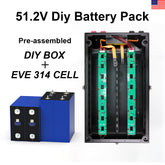How to Select the Right Power Supply for Your Standalone Fish Finder
Choosing the right power supply for your standalone fish finder is essential to ensure reliable operation and accurate readings. The power supply you use will directly affect the performance of your fish finder, especially if you're out on the water for extended periods. In this guide, we'll delve into how to choose the ultimate power source for your standalone fish finder, covering key factors to consider, from voltage requirements to battery life, and common mistakes to avoid.
- Understanding the Power Needs of Your Standalone Fish Finder
- Choosing the Best Power Supply: Key Factors to Consider
- Hedge Trimmer Power Supplies: How They Compare to Fish Finder Power Requirements
- How to Optimize Your Power Supply for Maximum Efficiency
- Hedge Trimmer Power Supply Insights for Fish Finder Users
Understanding the Power Needs of Your Standalone Fish Finder
The first step in selecting a power supply is understanding the electrical requirements of your fish finder. Different models require different amounts of voltage and current. Most standalone fish finders operate on a 12V DC system, but it’s crucial to double-check the specifications for your specific model. Using a power supply that doesn't match these requirements can lead to malfunctions or even permanent damage to the device.
Voltage Requirements
The voltage rating of your fish finder will determine the type of power source you need. Most standalone models will need a 12V battery, but higher-end units may require a more robust power supply. It's always a good idea to consult your fish finder’s manual to check the recommended voltage to ensure compatibility.
Current Draw
In addition to voltage, consider the current draw of your fish finder. Some units may consume more power than others, especially when operating at full capacity or using additional features like GPS. Be sure to choose a power supply that can handle the fish finder's peak current draw without overloading.
Choosing the Best Power Supply: Key Factors to Consider
Selecting the best power supply for your standalone fish finder is not just about meeting the voltage requirements. Several other factors influence your choice, including battery capacity, charging time, portability, and durability.
Battery Type and Capacity
There are various types of batteries to choose from, including lead-acid, lithium, and gel batteries. Lithium batteries are typically more efficient and compact, offering a longer battery life and shorter recharge times. However, they are also more expensive. Lead-acid batteries are a more affordable option but are bulkier and have a shorter lifespan.
For a fish finder, you'll typically need a battery with at least 7 to 10 amp-hours (Ah) of capacity for a full day of use. The greater the capacity, the longer the power supply will last before needing a recharge.
Battery Lifespan and Durability
When choosing a power supply, think about the longevity of the battery. A higher-end lithium battery may cost more upfront but can last for several years with proper care. Lead-acid batteries, on the other hand, are typically less expensive but may need to be replaced more frequently.
Charging Time
Another crucial aspect to consider is the charging time. Some batteries can take several hours to recharge fully, while others may take less time. If you plan to use your fish finder frequently, consider opting for a power supply that charges quickly to minimize downtime.
>>See also How Long Can A 12V 100Ah Battery Power Your Devices?
Hedge Trimmer Power Supplies: How They Compare to Fish Finder Power Requirements
Interestingly, the power needs for tools like hedge trimmers have some similarities with those of standalone fish finders. Like fish finders, hedge trimmers often require a specific voltage and current to operate efficiently. However, the difference lies in the usage frequency and duration.
Hedge Trimmer vs. Fish Finder Battery Size
While hedge trimmers generally don’t require as long a runtime as a fish finder, they do need a similar amount of voltage. In fact, if you're considering using a dual-purpose battery (such as one that powers both a hedge trimmer and your fish finder), it’s crucial to compare the voltage and current specifications closely to ensure both devices perform at their peak without overloading.
Hedge Trimmer Charging Considerations
Much like with your fish finder, when considering a power supply for your hedge trimmer, charging time and battery life are key factors. Make sure the power supply you choose for either tool can sustain its peak usage times while also offering a reasonable recharge period.
How to Optimize Your Power Supply for Maximum Efficiency
Once you've selected the ideal power supply, there are several ways you can optimize its performance to ensure that your fish finder continues to function efficiently for long periods.
Regular Maintenance
Just as you would maintain your fish finder to ensure longevity, it’s important to care for your power supply. Regularly check the battery for signs of wear and tear. Clean the terminals to prevent corrosion, and make sure the battery is securely mounted to avoid unnecessary movement or jarring during travel.
Power Supply Protection
Many modern power supplies come with built-in protection systems that guard against overcharging, short circuits, and voltage fluctuations. If your power supply doesn't include such features, consider investing in an external power protection device to safeguard both your fish finder and the power supply itself.
Hedge Trimmer Power Supply Insights for Fish Finder Users
A frequently asked question is whether a power supply designed for a hedge trimmer can be used for a fish finder. While both tools may have similar voltage requirements, it’s essential to ensure the current draw matches the specifications of your fish finder. In some cases, a hedge trimmer battery may not provide the sufficient current your fish finder requires, leading to performance issues.
Choosing the right power supply for your standalone fish finder is a key decision that impacts its performance, longevity, and overall user experience. By carefully considering factors such as voltage requirements, battery type, and charging time, you can ensure that your fish finder operates at its best during every outing. Additionally, understanding the similarities between power supplies for tools like hedge trimmers can help you make more informed decisions when selecting a battery that meets your needs. Ultimately, the right power supply will enhance your fishing experience and keep your fish finder running smoothly for years to come.
As you can see, selecting the ideal power supply for your standalone fish finder requires some careful consideration of multiple factors, including voltage requirements and battery life. If you’re unsure about what power supply to use, consulting with the manufacturer or an expert in the field can provide additional insight. Remember, a reliable power supply will ensure that your fish finder operates seamlessly, no matter where your next fishing adventure takes you.
>>See also The Ultimate Guide to Group 24 Battery 24F 24H 24R 24T
























Leave a comment
All blog comments are checked prior to publishing